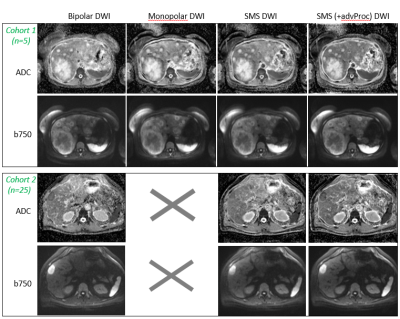Mihaela Rata1, Katja De Paepe1, Matthew R Orton1, Erica Scurr1, Julie Hughes1, Alto Stemmer2, Marcel Dominik Nickel2, and Dow-Mu Koh1
1Royal Marsden Hospital and Institute of Cancer Research, London, United Kingdom, 2Siemens Healthcare, Erlangen, Germany
1Royal Marsden Hospital and Institute of Cancer Research, London, United Kingdom, 2Siemens Healthcare, Erlangen, Germany
The study assessed the image quality of free-breathing
DWI acquisitions from 25 patients with liver metastases and compared SMS
(with/without advanced processing) DWI with standard bipolar echo planar DWI. The SMS protocol with advanced processing was faster
and showed better image quality.

Figure 1:
b750 images
and ADC maps
of liver metastases from two patients from each cohort: a 53-year old woman (top /
cohort 1) with colorectal cancer and a 61-year old man with bowel cancer
(bottom / cohort 2).Note the increased homogeneity signal across the slice on
both b-value and ADC images when using the prototype DWI with advanced options (columns
1 vs. 4). Moreover, the advanced option allows for a better delineation of the
liver or blood vessels as seen on the b750 images.
